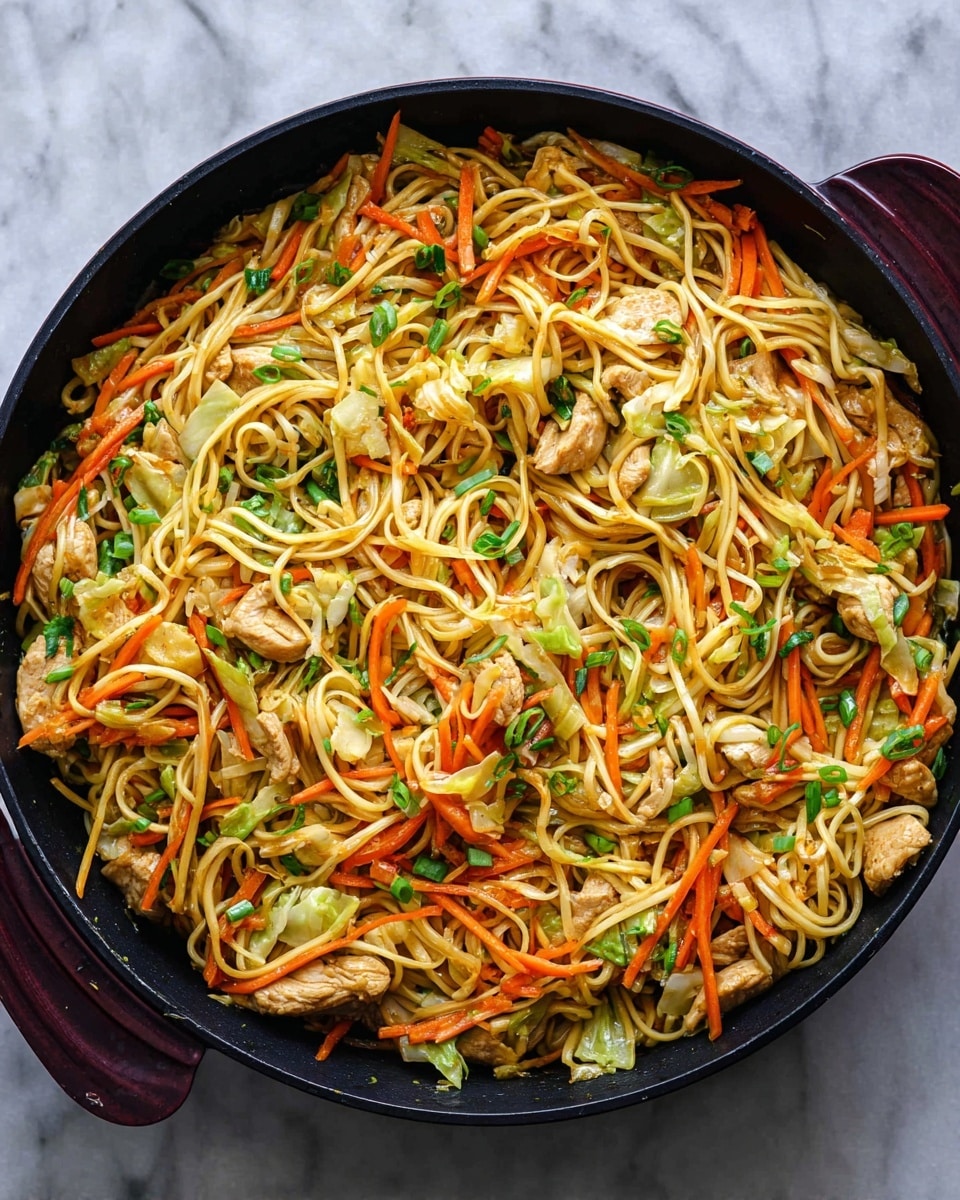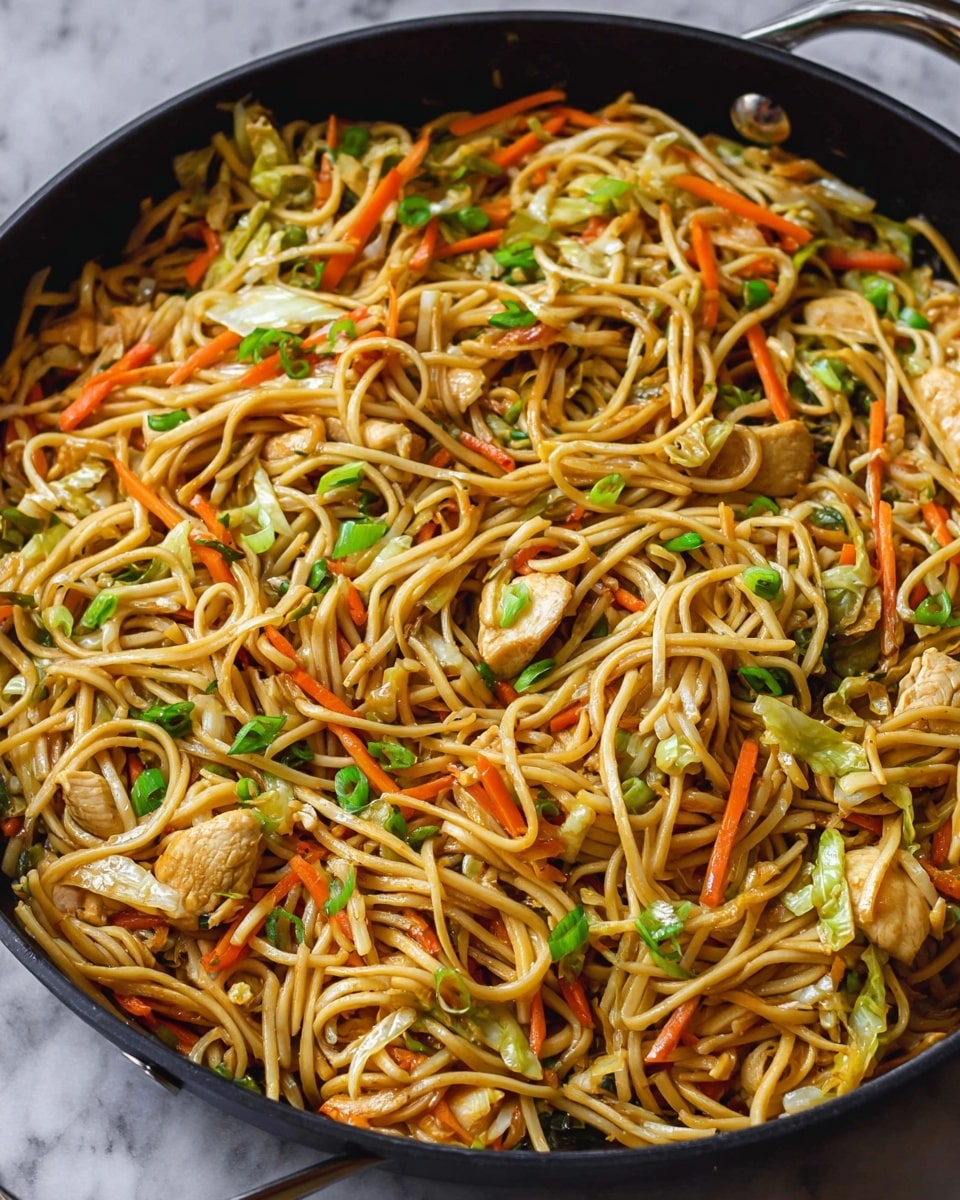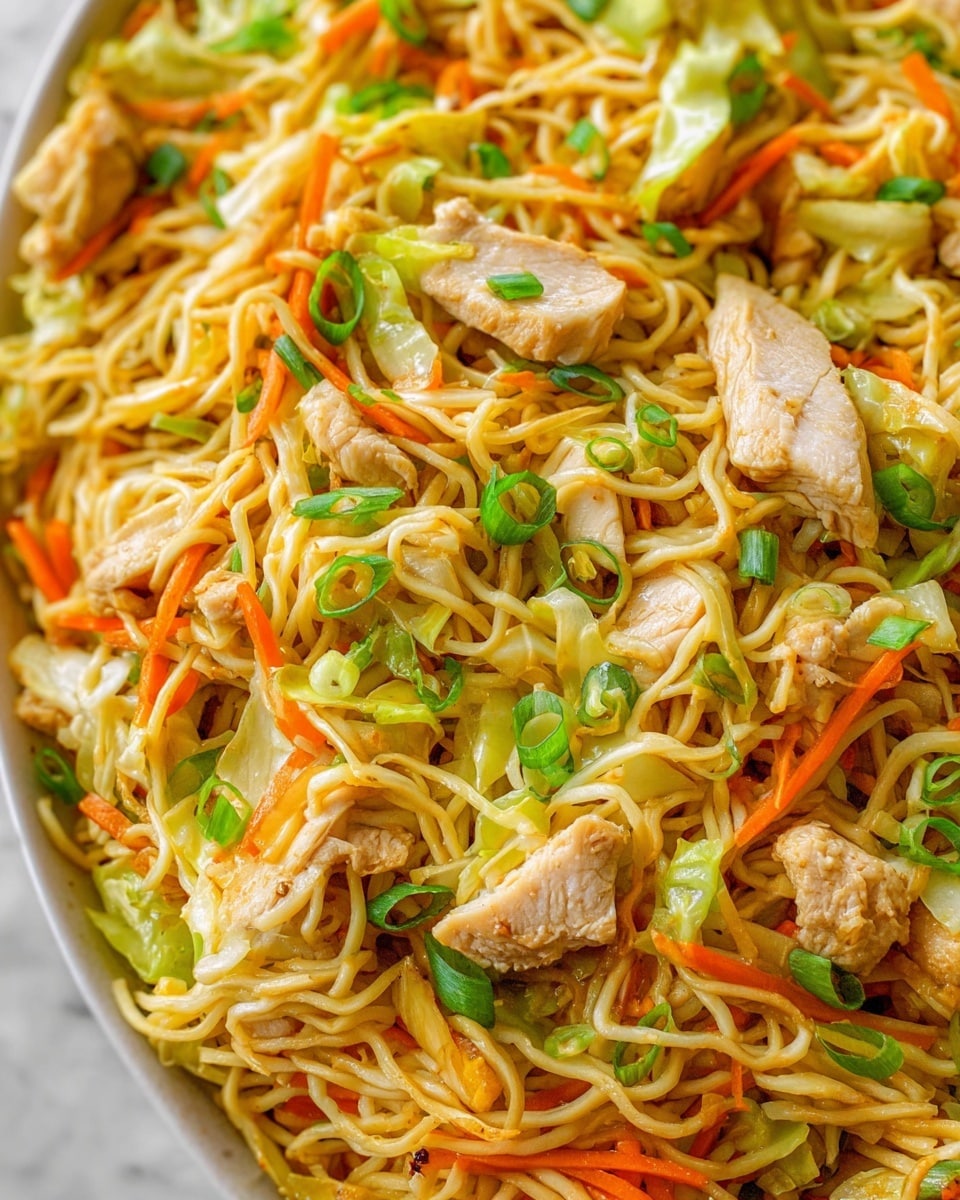If you’re craving a takeout favorite but want to whip it up at home with a special touch, you’re in the right place. I’m sharing my go-to Chicken Chow Mein with the Best Chow Mein Sauce Recipe that’s bursting with flavor and surprisingly easy to make. Trust me, once you try this, you’ll wonder why you ever ordered out instead of just cooking it yourself!
Why You’ll Love This Recipe
- Authentic Flavor: The carefully balanced chow mein sauce brings out rich, savory notes that will make your taste buds sing.
- Simple Ingredients: You won’t need a pantry full of exotic items—just a few everyday staples and some fresh veggies.
- Quick & Easy: Perfect for busy weeknights when you want something satisfying on the table fast.
- Customizable: This dish welcomes tweaks and variations, so you can make it your own.
Ingredients You’ll Need
This chicken chow mein blends fresh veggies, tender chicken breast, and those famously crispy chow mein noodles, all tied together with the best chow mein sauce you’ll find. Look for good-quality oyster and soy sauce to make the flavor pop.
- Chicken breast: Boneless and skinless works best for uniform pieces that cook quickly and stay juicy.
- Oil: I use a neutral cooking oil like vegetable or canola for stir-frying, but you can swap olive oil if preferred.
- Chow mein noodles: Uncooked is ideal; they get crispy and absorb the sauce well.
- Cabbage: Adds crunch and sweetness; thinly sliced for even cooking.
- Carrot: Julienned for that fresh color and subtle natural sweetness.
- Green onions: Chopped and tossed on top for a bright, oniony finish.
- Garlic: Pressed or minced – it’s the base flavor that wakes everything up.
- Oyster sauce: The soul of the sauce—choose a quality brand and adjust to taste.
- Soy sauce: I recommend low sodium to keep balance but go as you like.
- Light sesame oil: Not toasted—this keeps the sauce aromatic without overpowering.
- Chicken broth: Adds depth and keeps the sauce silky.
- Corn starch: Helps thicken the sauce for that perfect clinginess.
- Granulated sugar: Balances out the salty and savory components for harmony.
Variations
I like to keep this recipe flexible so you can make it suit your taste or what’s available in your fridge. You can add your favorite veggies or switch up the protein for diversity.
- Vegetable Boost: Sometimes I throw in snap peas or bell peppers for extra crunch and color, and my family loves it!
- Protein Switch: Try this with shrimp or tofu if you want a pescatarian or vegetarian option — just adjust cooking times accordingly.
- Spicy Kick: Adding a dash of chili flakes or sriracha to the sauce brings a pleasant heat that lifts the whole dish.
- Gluten-Free: Use tamari instead of soy sauce and gluten-free chow mein noodles to keep it safe for gluten-sensitive friends.
How to Make Chicken Chow Mein with the Best Chow Mein Sauce Recipe
Step 1: Whisk Together That Amazing Sauce
This is where the magic starts. I combine oyster sauce, soy sauce, light sesame oil, chicken broth, granulated sugar, and cornstarch in a small bowl and whisk until smooth. It’s important to get everything well mixed so the cornstarch doesn’t clump—this gives you that silky, luscious sauce consistency you want later.
Step 2: Cook the Noodles and Set Aside
Boil your chow mein noodles according to package instructions, usually just a couple of minutes, then drain and rinse with cold water. Rinsing stops the cooking and prevents stickiness. I find that setting them aside like this keeps them nice and springy for stir-frying.
Step 3: Sauté Chicken Until Golden
Heat your wok or a large skillet with oil over medium heat. Cut the chicken breasts into bite-sized strips and cook them until they get that beautiful golden brown on the outside. It’s tempting to overcrowd the pan, but trust me, giving the pieces some breathing room helps with better browning. Once cooked, remove the chicken and keep it warm.
Step 4: Softly Sauté Veggies
In the same pan, toss in your julienned carrots, sliced cabbage, and pressed garlic. You’ll want to sauté them just until the carrots soften slightly and the cabbage turns translucent—this keeps the texture lively without being too raw or mushy.
Step 5: Bring It All Together
Return the chicken to the pan along with the noodles, then pour your prepared chow mein sauce over everything. Toss and cook for another couple of minutes—this is when the sauce thickens and radiates its unbeatable flavor through every bite. Don’t rush here; giving the stir-fry time to finish cooking lets the noodles soak up all that saucy goodness.
Step 6: Garnish and Serve Hot
Sprinkle chopped green onions over the top just before serving for a fresh, crisp contrast. Serve the chow mein steaming hot straight from the pan—you’ll love how the aroma fills the kitchen at this point!
Pro Tips for Making Chicken Chow Mein with the Best Chow Mein Sauce Recipe
- Don’t Overcrowd Your Pan: I learned the hard way that cooking chicken and veggies in batches gives better flavor and texture.
- Adjust Oyster Sauce to Taste: Oyster sauce saltiness varies, so always taste your sauce before adding more.
- Keep Your Veggies Crisp: Sauté veggies just until tender to avoid a soggy chow mein—crunch is key here.
- Use Freshly Made Sauce: Mixing your sauce just before cooking locks in bright, fresh flavors instead of store-bought bottled sauces.
How to Serve Chicken Chow Mein with the Best Chow Mein Sauce Recipe

Garnishes
I always finish with freshly chopped green onions because they add a lovely oniony kick and a pop of color. Sometimes, if I want a little extra, I sprinkle toasted sesame seeds on top for a subtle nutty crunch. It’s those small touches that bring it all together.
Side Dishes
This chicken chow mein pairs wonderfully with simple stir-fried greens like bok choy or snap peas. If I’m in the mood for a bigger meal, I like serving it with steamed dumplings or a light miso soup on the side — perfect balance!
Creative Ways to Present
For a fun twist when friends come over, I serve the chow mein in little lettuce cups as handheld bites or pile it high in colorful bowls topped with extra herbs and a drizzle of sriracha. Presentation makes the meal feel festive and really impresses the crowd!
Make Ahead and Storage
Storing Leftovers
I store any leftover chicken chow mein in an airtight container in the refrigerator and try to eat it within 2-3 days. The noodles soak up sauce over time, so leftovers taste even better but lose some crispness—still delicious!
Freezing
I don’t usually freeze chow mein because the noodles can get mushy when thawed, but if you must, freeze the cooked chicken and veggies separately and toss with freshly cooked noodles when reheating for best texture.
Reheating
Reheat leftovers in a hot skillet over medium heat. This way, any excess moisture evaporates, and the noodles get a bit of that delicious crisp back. Microwave works in a pinch, but the skillet method is my favorite for bringing back the original texture.
FAQs
-
Can I use chicken thighs instead of breast for this Chicken Chow Mein recipe?
Absolutely! Chicken thighs are a great alternative if you prefer a juicier, more flavorful meat. Just cut them into similar-sized pieces and cook until browned and cooked through. Keep in mind thighs may take a little longer to cook than breasts.
-
What if I can’t find chow mein noodles?
If you can’t find chow mein noodles, egg noodles or thin spaghetti can work in a pinch—just cook according to package directions. For that signature chow mein crunch, crisping up the noodles in the pan before adding sauce helps mimic the texture.
-
How spicy is this Chicken Chow Mein recipe?
This recipe is mild by default, making it family-friendly and perfect if you prefer your food without heat. You can easily add chili flakes, fresh chilies, or hot sauce to taste if you want to kick up the spice factor.
-
Can I make the sauce ahead of time?
Yes! The sauce can be mixed a few hours or even a day ahead and stored in the fridge. Just give it a quick whisk before adding it to your stir-fry to make sure the cornstarch hasn’t settled.
Final Thoughts
This Chicken Chow Mein with the Best Chow Mein Sauce Recipe has become a staple in my kitchen because it’s just so reliable and delicious. I love how it brings the comforting vibes of takeout right to my dining table, with the added bonus of knowing exactly what’s going in each bite. Give it a try, tweak it your way, and I promise you’ll be making it again and again—your family and friends will thank you, too!

Chicken Chow Mein with the Best Chow Mein Sauce Recipe
- Prep Time: 15 minutes
- Cook Time: 20 minutes
- Total Time: 35 minutes
- Yield: 8 servings 1x
- Category: Main Course
- Method: Stovetop
- Cuisine: Chinese
Description
This Chicken Chow Mein recipe features tender chicken breast strips stir-fried with fresh vegetables and crispy chow mein noodles, all tossed in a rich, flavorful homemade chow mein sauce. Perfect for a quick yet satisfying meal with an authentic Asian flair, this dish combines the perfect balance of savory oyster sauce, sesame oil, and soy sauce for a crowd-pleasing stir-fry.
Ingredients
Main Ingredients
- 1 lb chicken breast, boneless, skinless
- 3 Tbsp oil (such as olive or vegetable oil)
- 12 oz chow mein noodles (uncooked noodles)
- 2 cups cabbage, chopped
- 1 large carrot, julienned
- 1/2 batch green onions, chopped
- 2 garlic cloves, pressed or minced
Chow Mein Sauce
- 4 Tbsp oyster sauce (adjust to taste, salt content varies)
- 3 Tbsp low sodium soy sauce
- 3 Tbsp light sesame oil (not toasted)
- 1/2 cup chicken broth
- 1 Tbsp cornstarch
- 1 Tbsp granulated sugar
Instructions
- Prepare the sauce: In a small mixing bowl, whisk together the oyster sauce, granulated sugar, sesame oil, soy sauce, chicken broth, and cornstarch until smooth. Set this sauce mixture aside to allow flavors to meld.
- Cook the noodles: Boil the chow mein noodles according to package instructions until al dente. Drain the noodles, rinse them with cold water to stop cooking and prevent sticking, then set aside.
- Cook the chicken: Heat a large wok or pan over medium heat and add the oil. Cut the chicken breasts into bite-sized strips, then sear and cook them in the hot oil until they develop a golden brown color and are cooked through. Remove the chicken from the pan and set aside.
- Sauté the vegetables: In the same pan, add the julienned carrots, chopped cabbage, and pressed garlic. Sauté these ingredients for a few minutes until the vegetables soften slightly and the cabbage becomes a bit translucent, enhancing their flavor and texture.
- Combine and finish cooking: Return the cooked chicken strips and the drained chow mein noodles to the pan with the vegetables. Pour the prepared chow mein sauce over the mixture, tossing everything together to coat evenly. Continue cooking for another 2 minutes, allowing the sauce to thicken and coat all ingredients thoroughly.
- Garnish and serve: Remove the pan from heat and garnish the chow mein with chopped green onions. Serve the noodles hot directly from the pan for the freshest taste and texture.
Notes
- When using cooked chow mein noodles instead of uncooked, use about 1 lb of cooked noodles to maintain proper texture and flavor balance.
- Oyster sauce saltiness can vary by brand, so taste the sauce and adjust the oyster sauce quantity accordingly, especially if using regular soy sauce instead of low sodium.
- This recipe is sponsored by Mashreq.
- Ensure vegetables are not overcooked; they should retain a slight crunch for the best texture.
Nutrition
- Serving Size: 1 serving (approximately 1/8th of recipe)
- Calories: 340
- Sugar: 5g
- Sodium: 600mg
- Fat: 12g
- Saturated Fat: 2g
- Unsaturated Fat: 8g
- Trans Fat: 0g
- Carbohydrates: 38g
- Fiber: 3g
- Protein: 28g
- Cholesterol: 70mg




Your email address will not be published. Required fields are marked *